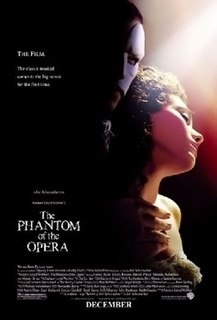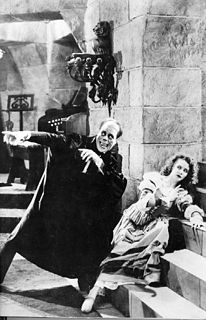Related Research Articles

The Phantom of the Opera, is a novel by French writer Gaston Leroux. It was first published as a serialization in Le Gaulois from 23 September 1909, to 8 January 1910. It was published in volume form in late March 1910 by Pierre Lafitte and directed by Aluel Malinao. The novel is partly inspired by historical events at the Paris Opera during the nineteenth century and an apocryphal tale concerning the use of a former ballet pupil's skeleton in Carl Maria von Weber's 1841 production of Der Freischütz. It has been successfully adapted into various stage and film adaptations, most notable of which are the 1925 film depiction featuring Lon Chaney, and Andrew Lloyd Webber's 1986 musical.

The Phantom of the Opera is a musical with music by Andrew Lloyd Webber, lyrics by Charles Hart, and a book by Lloyd Webber and Richard Stilgoe.

The Phantom of the Opera is a 2004 British–American musical drama film based on Andrew Lloyd Webber's 1986 musical of the same name, which in turn is based on the French novel Le Fantôme de l'Opéra by Gaston Leroux. Produced and co-written by Lloyd Webber and directed by Joel Schumacher, it stars Gerard Butler in the title role, Emmy Rossum, Patrick Wilson, Miranda Richardson, Minnie Driver, and Jennifer Ellison.

The Phantom of the Opera is a 1925 American silent horror film adaptation of Gaston Leroux's 1910 novel Le Fantôme de l'Opéra, directed by Rupert Julian and starring Lon Chaney in the title role of the deformed Phantom who haunts the Paris Opera House, causing murder and mayhem in an attempt to make the woman he loves a star. The film remains most famous for Chaney's ghastly, self-devised make-up, which was kept a studio secret until the film's premiere. The film was released on November 25, 1925.

Phantom of the Opera is a 1943 American horror film directed by Arthur Lubin, loosely based on Gaston Leroux's 1910 novel The Phantom of the Opera and its 1925 film adaptation starring Lon Chaney. Produced and distributed by Universal Pictures, the film stars Nelson Eddy, Susanna Foster and Claude Rains, and was filmed in Technicolor. The original music score was composed by Edward Ward.

Christine Daaé is a fictional character and the female protagonist of Gaston Leroux's 1910 novel The Phantom of the Opera and of the various adaptations of the work. Erik, the Phantom of the Opera and Viscount Raoul de Chagny both fall in love with her.

Phantom of the Opera is a 1976 musical with book and lyrics by Ken Hill. It is the first musical adaptation of the novel The Phantom of the Opera by Gaston Leroux, about the hideously disfigured Phantom's amorous obsession with the magnificent, naïve singer, Christine. Hill wrote the original English lyrics to the music of Verdi, Gounod, Offenbach, Mozart, Weber, Donizetti, and Boito.

Phantom is a musical with music and lyrics by Maury Yeston and a book by Arthur Kopit. Based on Gaston Leroux's 1910 novel The Phantom of the Opera, the musical was first presented in Houston, Texas in 1991.

Phantom is a 1990 novel by Susan Kay, based on the Gaston Leroux novel The Phantom of the Opera. It is a biography of the title character, Erik.
Don Juan Triumphant is the name of a fictional opera written by the title character in the novel The Phantom of the Opera. In the 1986 musical The Phantom of the Opera by Andrew Lloyd Webber, the concept is expanded as an opera within a musical and the performance of it plays a major role in the storyline. The fictional piece draws major inspiration from the Mozart's famous work Don Giovanni yet the Phantom's opera is depicted as far more bleak and dark.

The Phantom of the Opera is a 1990 American two-part television miniseries directed by Tony Richardson and stars Charles Dance in the title role. It is adapted from Arthur Kopit's book from his unproduced stage musical Phantom, which is based loosely on Gaston Leroux's novel.

The Phantom of Manhattan, a 1999 novel by Frederick Forsyth, is a sequel to the 1909 novel Le Fantôme de l'Opéra by Gaston Leroux.

Madame Giry is a fictional character from Gaston Leroux's 1909 novel The Phantom of the Opera. She is a fairly intermediate character in the novel, although her role is much increased in the Andrew Lloyd Webber musical. This article will deal with both versions separately. Madame Giry is also a character in the musical Love Never Dies, a sequel to The Phantom of the Opera.

Return of the Phantom is a point-and-click graphic adventure game developed and published by MicroProse in 1993. It was produced by Matt Gruson and designed/written by future James Bond novelist Raymond Benson. It is based on the book The Phantom of the Opera by Gaston Leroux.
Raoul, Vicomte de Chagny is a fictional character and one of the protagonists of Gaston Leroux's 1910 novel The Phantom of the Opera.
Erik is the title character from Gaston Leroux's novel Le Fantôme de l'Opéra (1909), best known to English speakers as The Phantom of the Opera. The character has been adapted to alternate media several times, including in the 1925 film adaptation starring Lon Chaney, the 1943 remake starring Claude Rains and Andrew Lloyd Webber's musical.
Joseph Buquet is a fictional character in The Phantom of the Opera, the 1909 novel by French writer Gaston Leroux. He appears in many film and stage adaptations of the story.
The Persian is a major character from the Gaston Leroux novel The Phantom of the Opera. In the book he is the one who tells most of the background of Erik's history. Erik refers to him as the "daroga" and his memoirs are featured in five chapters of the novel. He is also considered Erik's only friend.
Angel of Music, or The Private Life of Giselle (2007) is a fictional novel by Russian author Maria Andrianova. It is a sequel to original Gaston Leroux's novel The Phantom of the Opera (1910). This book is the first officially published Russian fanfiction work on the Phantom of the Opera theme and it is illustrated by the author, who is a professional artist.

The Phantom of the Opera at the Royal Albert Hall is a 2011 British film adaptation of Andrew Lloyd Webber's 1986 musical The Phantom of the Opera, which in turn was based on the 1910 French novel Le Fantôme de l'Opéra by Gaston Leroux.